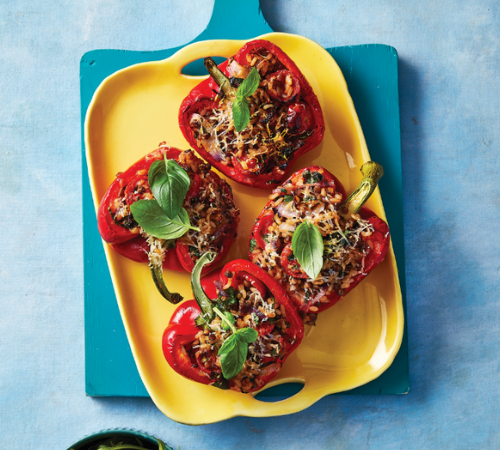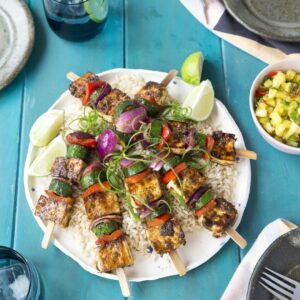
Too little of this essential mineral can leave you feeling tired, stressed and moody, and sabotage your sex drive. But good news: it’s easy to boost your intake with a few diet swaps.
If you’re too tired for passion and prefer to snuggle up with a box set, or if you find just getting through the day is an effort, it’s time to check your iron levels.
Exhaustion is a telltale sign of iron deficiency. That’s because iron is vital for making haemoglobin, which carries around your body the oxygen every organ needs to stay energised.
When everyday tasks exhaust you, getting frisky is going to be the last thing on your mind. This is where diet can help. Meat is a prime source of iron, but there are other sources too, such as fortified breakfast cereals, Marmite and cashew nuts. So, whether you want to put a spring back in your step or the va-va-voom back in the bedroom, we’ve got the know-how and the menu swaps to help you boost your iron intake.
Effects of too little iron
Feeling low and run down?
As mentioned, iron has a crucial role in helping haemoglobin – the red pigment in our blood – carry oxygen to every cell in our body. This is why too little iron can impact both our physical and emotional well-being, leaving us feeling run down and low. Work becomes more difficult, with reduced concentration and focus. We also become more susceptible to stress and mood swings.
Deficiency in women
Ten per cent of all women in New Zealand, compared with only one per cent of men, have iron intakes lower than recommended. While full-blown iron-deficiency anaemia affects only six per cent of women aged 31-50, sub-clinical deficiency (where you feel worn out but aren’t yet showing clinical signs of deficiency) is more widespread.
Growing problem
Thirty-four per cent of NZ girls aged 15-18, compared with five per cent of boys, have a very low intake. When kids grow quickly they need more iron.
With such a high proportion of this group not meeting the recommended intake, it’s easy to see how iron deficiency can present a problem in adolescence, affecting energy levels and concentration.
Choosing great sources of iron can help make sure young athletes and dancers don’t fade too quickly.
Boost your iron
Animal vs plant sources
Iron from animal sources (haem iron) is better absorbed than that from plant sources (non-haem iron), which is why including meat (especially red meat) in your diet is beneficial. But plant-based sources of non-haem iron actually make up the majority of our dietary intake. These include whole grains, vegetables, fruits, pulses, hummus and nuts.
Is there anything that reduces absorption?
The tannins in tea and coffee inhibit non-haem iron absorption, so if you drink a cuppa with your iron-fortified breakfast cereal, you won’t be getting the full benefit. Wait half an hour before having your tea or coffee to allow the iron to be absorbed first. Whole grains are a good source of iron, but they also contain phytic acid which can stop the body using the iron effectively.
How to aid absorption
Eating a food containing vitamin C (including many fruits and vegetables) alongside an iron-rich meal means your body will absorb more iron. So, pile your plate with veges – especially red, yellow and orange capsicums, tomatoes, cabbage and broccoli – to maximise your intake. And have a kiwifruit or orange slices with your cereal.
Easy swaps to get more iron in your day
Breakfast: Swap the usual…
Instead of: Fruit yoghurt and a cup of tea • 610kJ • 0mg iron
Swap for: Iron-fortified All-Bran wheat flakes with 150ml trim milk and 1/4 cup blueberries • 970kJ • 4mg iron

Instead of: 2 slices white toast with butter and jam • 1130kJ • 0.5mg iron
Swap for: 2 slices multigrain toast with low-fat spread and Marmite • 1080kJ • 6mg iron

Instead of: 2 scrambled eggs and 1 rasher bacon • 810kJ • 2mg iron
Swap for: Baked egg and mushroom toast topper • 800kJ • 3.5mg iron

Instead of: 1 cup porridge made with trim milk • 730kJ • 1.5mg iron
Swap for: Overnight oats • 1740kJ • 5.5mg iron

Instead of: 2 slices wholemeal bread with avocado and tomato • 1660kJ • 2mg iron
Swap for: Corn and capsicum fritters with avocado smash • 1890kJ • 5.5mg iron

Lunch: Swap the usual…
Instead of: Salmon salad with brown rice • 2150kJ • 1.5mg iron
Swap for: Warm salmon, egg and quinoa salad • 2160kJ • 5mg iron

Instead of: Cheese and tomato sandwich on wholemeal bread • 1460kJ • 1mg iron
Swap for: Creamy chicken and avocado open sandwich • 2430kJ • 4.5mg iron

Instead of: Jacket potato with cheese • 1550kJ • 1mg iron
Swap for: Jacket potato with reduced-sugar-and-salt baked beans • 1200kJ • 3mg iron

Instead of: Roasted vegetable and pasta salad • 1790kJ • 2.5mg iron
Swap for: Beef udon noodles • 1820kJ • 4.5mg iron

Instead of: Pumpkin and carrot soup with 2 slices wholemeal bread and margarine • 900kJ • 2mg iron
Swap for: Moroccan lamb, tomato and kumara soup • 1800kJ • 6.5mg iron

Dinner: Swap the usual…
Instead of: Spaghetti with carbonara sauce • 2300kJ • 2mg iron
Swap for: Spaghetti with bolognese sauce • 2200kJ • 7.5mg iron

Instead of: Small salmon steak with pesto, new potatoes and broccoli • 2120kJ • 2mg iron
Swap for: Beef steak with potato, silver beet and peas • 1650kJ • 5.5mg iron

Instead of: Egg and cheese vegetarian quiche • 1330kJ • 1mg iron
Swap for: Silver beet, ricotta and broccoli pie • 1330kJ • 2mg iron

Instead of: Fish tacos with salad • 2230kJ • 2mg iron
Swap for: Quick pineapple prawn stir fry • 2170kJ • 4.5mg iron

Instead of: 2 wraps with capsicum, mushroom, onion and cheese • 2180kJ • 1.5mg
Swap for: Tandoori chicken wrap • 2120kJ • 3mg iron

Snacks: Swap the usual…
Instead of: Milk chocolate bar (50g) • 1120kJ • 1mg iron
Swap for: 2 Choc cranberry bliss balls • 1080kJ • 1.5mg

Instead of: 1 cup potato chips • 560kJ • 0mg iron
Swap for: 3 cups natural popcorn • 430kJ • 1mg iron

Instead of: 50g peanuts and raisin mix • 920kJ 1mg iron
Swap for: 3 dried apricots and 30g unsalted cashew nuts • 850kJ • 2mg

Instead of: Apple and a regular flat white • 650kJ • 0mg
Swap for: 80g canned prunes and 125g low-fat plain yoghurt • 640kJ • 1mg iron

Instead of: Cheese and 3 crackers • 750kJ • 0mg iron
Swap for: Carrot sticks and 3 tablespoons hummus • 450kJ • 1mg iron

Great ways to get your daily iron
- Beef mince • 1 cup • 4.5mg
- Green mussels • 1/2 cup • 4mg
- Beef steak • 150g • 3mg
- Lamb chop • 150g • 2.5mg
- Chicken liver pâté • 1 tablespoon • 1.5mg
- Canned salmon • small can • 1mg
- Chicken breast • 150g • 1mg
- Tarakihi fillet • 150g • 0.5mg
- Red lentils • 1/4 cup (uncooked) • 3.5mg
- Tofu • 100g • 5.5mg
- Rolled oats • 1/2 cup • 3mg
- Weet-bix (fortified) • 2 biscuits • 3mg
- Marmite • 1 teaspoon • 2.5mg
- Spinach • 1 cup • 2mg
- Multigrain bread • 1 slice • 0.5mg
- Hummus • 2 tablespoons • 0.5mg
Did you know?
- Women aged up to 50 need 18mg of iron per day and men and women over 50 years need 8mg. In reality, most women eat only 9.9mg but men get 13.2mg.
- Kiwi kids get 18 per cent of their daily iron from breakfast cereals, more than double the iron they get from beef. For adults, bread is the biggest single source of iron in our diet.
- Six months is the length of time it takes to treat iron-deficiency anaemia. Your GP will prescribe iron tablets that are stronger than over-the-counter supplements. You can’t treat this condition through diet alone.
- Not just food: Giving blood, nose bleeds and menstruation are other reasons why women may be anaemic. In New Zealand, research also shows that Maori, Pacific Island and Asian women and girls are more at risk of iron deficiency. The reason for this is unknown, but may be due to genetics or dietary patterns.
Article sources and references
- Beck K. et al. 2014. Blood donation, being Asian and a history of iron deficiency are stronger predictors of iron deficiency than dietary patterns in premenopausal women. Biomed Research International doi:10.1155/2014/652860https://mro.massey.ac.nz/bitstream/handle/10179/11318/Blood%20donation%2C%20being%20Asian%2C%20and%20a%20history%20of%20iron%20deficiency%20are%20stronger%20predictors%20of%20iron%20deficiency%20than%20dietary%20patterns%20in%20premenopausal%20women..pdf
- National Health and Medical Research Council, Australian Government Department of Health and Ageing, New Zealand Ministry of Health. 2006. Nutrient Reference Values for Australia and New Zealand: Version 1.1 Updated March 2017. Canberra: National Health and Medical Research Councilhttps://www.nhmrc.gov.au/sites/default/files/images/nutrient-refererence-dietary-intakes.pdf
- University of Otago and Ministry of Health. 2011. A Focus on Nutrition: Key findings of the 2008/09 New Zealand Adult Nutrition Survey. Wellington: Ministry of Healthhttps://www.health.govt.nz/publication/focus-nutrition-key-findings-2008-09-nz-adult-nutrition-survey
www.healthyfood.com










